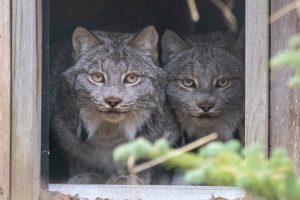Summary of Potter Park Zoo Welcomes New Species: Canadian Lynx Brothers Ragnar and Rollo:
Potter Park Zoo in Lansing, Michigan, is excited to announce the arrival of two new residents, Canadian lynx brothers Ragnar and Rollo, who are 4 years old and come from the Pittsburgh Zoo and Aquarium. These majestic animals are adjusting well to their new home and are already enchanting visitors with their presence. Zoo Director Cynthia Wagner emphasized the opportunity for the community to learn about this new species and praised the staff for their excellent preparation for the lynxes’ arrival.
Canadian lynxes, or Lynx canadensis, are native to North America’s northern regions, specifically known for residing in boreal forests rich in undergrowth. These cats are admired for their beautiful appearance and distinctive hunting skills. However, they face numerous challenges due to habitat destruction caused by logging, road building, and habitat fragmentation. Changes in the natural fire cycles affecting lodgepole pines and reducing snowshoe hare populations (their prey) significantly impact their populations.
Potter Park Zoo is committed to conserving Canadian lynxes, providing Ragnar and Rollo with a nurturing environment to thrive. The zoo invites the public to visit and learn more about these fascinating animals and the importance of conserving their species and habitats. Potter Park Zoo, home to nearly 300 animals, including various endangered and critically endangered species, is open 364 days a year and offers educational opportunities about wildlife conservation.
The introduction of Canadian lynx Ragnar and Rollo to Potter Park Zoo enhances species diversity and educational opportunities.
– The conservation challenges the Canadian lynx faces in their natural habitats highlight the importance of zoos in wildlife preservation.
– The role of Potter Park Zoo in Michigan in promoting awareness and engagement in conservation efforts.
– Insights into the natural history and biology of the Canadian lynx to foster a deeper understanding and appreciation among zoo visitors.
—
Potter Park Zoo in Lansing, Michigan, recently expanded its collection of wildlife by welcoming two Canadian lynx brothers, Ragnar and Rollo, from the Pittsburgh Zoo and Aquarium. These four-year-old lynxes are expected to play a crucial role in educating visitors about their species while also contributing to their kind’s genetic diversity and conservation efforts. Having prepared extensively for their arrival, the zoo staff look forward to integrating them into the zoo’s array of educational programs designed to inspire action towards wildlife conservation.
Canadian lynxes, scientifically known as Lynx canadensis, are remarkable creatures adapted to the cold environments of North America’s northern forests. Their presence at Potter Park Zoo is an excellent opportunity for visitors to learn about the species’ unique adaptions, such as their large paws acting as snowshoes in deep snow, aiding in the pursuit of prey, primarily the snowshoe hare. However, these adaptations also cast light on the daunting conservation challenges they face, including habitat loss and the decline of their prey, both consequences of human activities like logging and road construction.
The arrival of Ragnar and Rollo at Potter Park Zoo not only enriches the diversity of animals the park houses but also underscores the zoo’s commitment to conservation. By providing these lynx brothers with a secure environment that closely mimics their natural habitat, the zoo plays a pivotal role in the ongoing efforts to ensure the survival of species facing threats in the wild. Moreover, through educational programs and up-close encounters, the zoo fosters a connection between visitors and these less commonly known felines, emphasizing the importance of conservation action.
Potter Park Zoo’s efforts with the Canadian lynx reflect a microcosm of global wildlife preservation endeavors, illustrating the broader implications of individual species conservation. Zoos often serve as arks of hope for many species, offering a haven and acting as centers for research and public education. The story of Ragnar and Rollo at Potter Park Zoo contributes to a larger narrative of human responsibility toward our planet’s biodiversity.
Delving deeper into the biology and ecology of the Canadian lynx, we see that these animals are solitary and primarily nocturnal and adapted to hunting in the dense boreal forests of North America. Understanding these behaviors and adaptations is crucial for effective conservation strategies, both in situ (in their natural habitat) and ex-situ (outside their natural habitat, such as in zoos). Educating the public about these aspects through interactive and engaging means such as guided tours, informative plaques, and digital content can significantly enhance the visitor experience, turning a day at the zoo into an invaluable learning opportunity.
Potter Park Zoo, home to nearly 300 animals, has long been involved in conservation and education efforts, striving to provide a sanctuary for endangered and threatened species from around the globe. The addition of the Canadian lynx brothers adds to this mosaic of global biodiversity and offers a window into the wild for zoo visitors. Through knowledge dissemination and engaging experiences, the zoo aspires to cultivate an appreciation for wildlife and inspire action towards conservation efforts.
The Canadian lynx’s introduction to the zoo’s populace is a beacon of educational and conservation possibilities. By highlighting the species’ challenges, Potter Park Zoo encourages visitors to contemplate humanity’s impact on wildlife and the steps necessary to mitigate these effects. As a center for conservation, education, and recreation, Potter Park Zoo exemplifies how zoos can contribute to the conservation of species like the Canadian lynx, engaging the community in meaningful discussions about our shared environment and its future.
The story of Ragnar and Rollo is just one of many at Potter Park Zoo, but it encapsulates the broader mission of zoos worldwide: to conserve, educate, and inspire. Through the lens of the Canadian lynx, visitors can gain a broader understanding of the complex interconnections within natural ecosystems and the crucial role humans play in maintaining the balance. As such, including these magnificent felines in the zoo’s lineup is a powerful educational tool, driving home the message of coexistence and the importance of every individual effort in the greater conservation endeavor.


